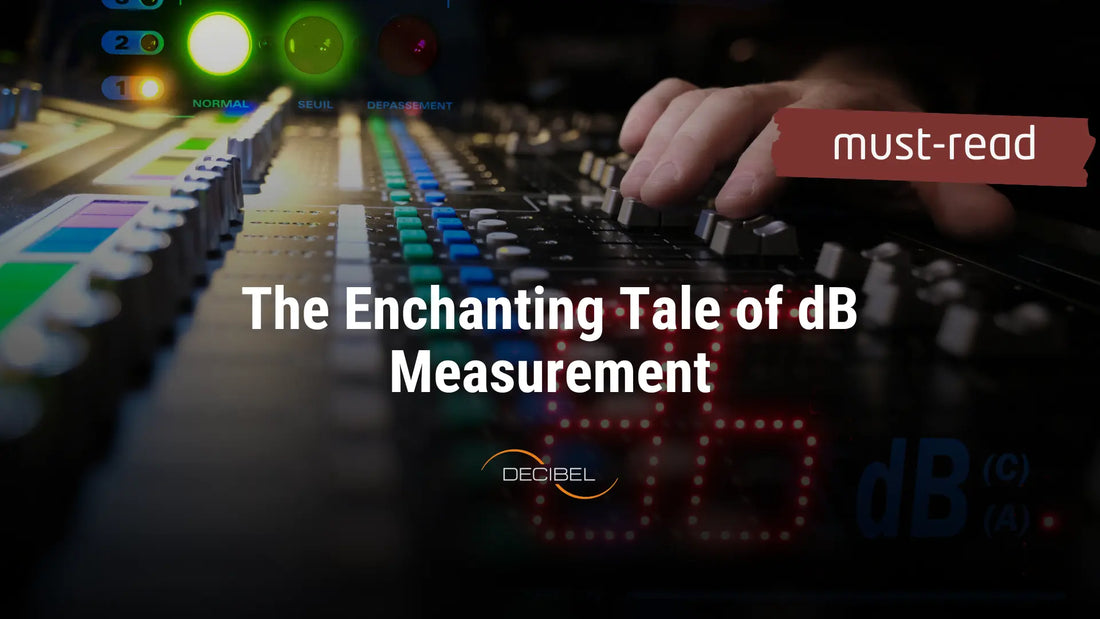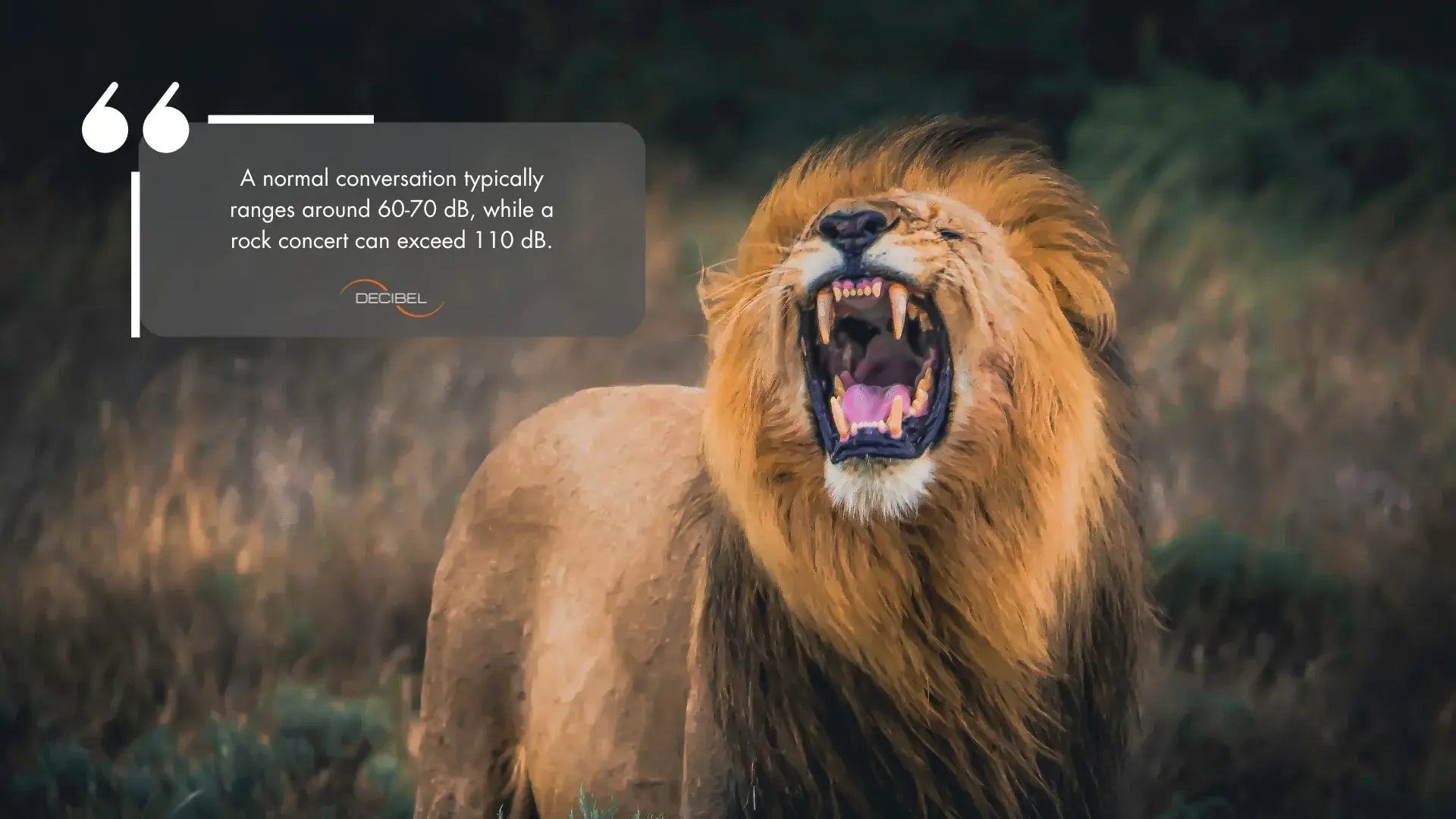
The Enchanting Tale of dB Measurement
Tanya IlievaShare
📖 Reading time: 10 min 54 sec
Sound is vast, powerful, and full of hidden depths like the ocean. Some waves lap gently at the shore, while others crash with unstoppable force, like a jet engine at takeoff. But how do we measure these waves of sound? How do we make sense of something as intangible as loudness? The answer lies in a measurement we take for granted - one that shapes our world in ways we rarely consider: the decibel (dB).
More than just a unit of loudness, the dB dictates our perception of the world around us. But where did this enigmatic unit come from, and why is it measured logarithmically instead of linearly?
Time to find out...
The Birth of dB
The fascinating story of the dB dates back to the early 20th century. The world wanted a standard unit to measure the varying loudness of sound. As industries expanded and technology advanced, there was a pressing need to measure sound consistently and meaningfully.
In 1924, the stage was set for a great American electrical engineer, A. H. Taylor, to step forward. He was the one to conceive the idea of decibels. Taylor was like a master magician. He drew inspiration from the logarithmic scale, a key tool in math and physics. He ingeniously adapted it for measuring sound. This novel logarithmic system captured the details of sound. It allows for a more precise and manageable representation of its vast range.
Taylor's dB scale was like a grand illusion. It transformed audio engineering. It provided a new way to express sound's intensity. And it did so concisely and meaningfully. It opened up new possibilities for musicians, sound techs, and scientists. They could now set sound levels in different places and do it more easily and accurately.
Over the years, the dB scale became the common language of sound measurement. It crossed borders and united a global community of audio fans and pros. This is the ability to compress a wide range of sound volumes into a short, logarithmic format. It enabled universal communication and collaboration. It was like a common language uniting people from all walks of life.

Decoding the dB and its Fascinating Naming Story
But what exactly is a dB? It's not a person or a mythical creature. Instead, dB is a unit of measurement. It comes from logarithms, a math concept that compresses the wide range of sound.
The term "decibel" itself holds an intriguing story behind its name. A. H. Taylor (if you remember the guy from the previous paragraph) was a brilliant electrical engineer. He first introduced this new unit of sound measurement in 1924. He had to find a name that captured the scale's essence. It needed to be suitable for a logarithmic scale.

The prefix "deci-" means one-tenth (1/10) in the International System of Units (SI). Taylor ingeniously combined it with "bel." The name was given in honour of Alexander Graham Bell, the inventor of the telephone.
The name "bel" recognised Bell's groundbreaking work in tech. Taylor felt it was a fitting tribute to honour the origins of his research. However, the bel, being a large unit for most sound measurements, was found to be impractical.
As a result, Taylor decided to use the decibel (dB). It is one-tenth of a bel and the standard unit of sound measurement. The name change aligned perfectly with the scale's logarithmic nature. It made sound intensities simpler to represent without losing precision.
Understanding the Magic of Logarithms
Let's talk about logarithms. They turn complex math into simple and elegant transformations. Decibels measure the loudness of sounds. They compress the wide range of sound intensities into a scale. The range goes from whispers to roars. Logarithms have this unique trait. It lets us hear sounds like our ears do. They are non-linear. They give a more accurate picture of what we hear.
Logarithms make the dB scale indispensable in many fields. It spans audio engineering, telecommunications, and environmental analysis, as well as health and safety regulations. dB measurement lets us navigate and understand sound with precision and ease.
Exploring the Magnitude of Sound
One of the enchanting qualities of dBs is their universal nature. We all speak different languages and have different cultures. But, dB measurements go beyond these differences. They give us a common ground for understanding sound. Musicians, sound engineers, and fans worldwide use dB to communicate and collaborate, forming a shared language.
Now that we understand the essence of dB, let's embark on a sonic adventure. Picture yourself in nature. You hear the gentle rustling of leaves. It's a peaceful moment that registers at 30 dB. But wait! A roaring jet engine in the distance captures your attention. It makes a whopping 120 dB. From whispers to loud claps, dB measurement captures the diverse soundscapes that shape our lives.
Did you know that normal conversations are typically 60-70 dB loud? Rock concerts can exceed 110 dB. This shows the wide range of sound intensities. And guess what, you can measure them using dBs.

5 Applications to Showcase dB in Action
Do you know where dB measurement is used? Exactly, almost everywhere. Today, the world uses dB measurement in many industries and everyday applications. Let's explore them:
1. Occupational Safety and Health
In loud workplaces, like construction sites and factories, dB measurement protects workers' hearing.
Did you know that? The US Occupational Safety and Health Administration (OSHA) sets permissible exposure limits. The maximum is 85 dB for an eight-hour work shift. This regulation aims to prevent hearing loss. It is caused by noise and affects millions of workers globally.
2. Audio Engineering and Music Production
In the realm of music and audio engineering, dB is the guiding compass. Audio engineers carefully control sound levels. They do this during recordings, live performances, and post-production. This is to create captivating sound experiences.
Did you know that? In studios, sound levels are set to 85-90 dB on average. This level is meant to give clear sound without tiring listeners.

3. Environmental Noise Analysis
In cities, noise pollution is a growing concern. dB measurement is used to analyze and reduce noise levels. City planners and environmentalists use dB data. They use it to assess the impact of traffic noise on homes. They use it to make plans to reduce noise.
Did you know that? Some cities even have noise ordinances. They keep sound at acceptable levels during specific hours.
4. Healthcare and Audiological Testing
In audiological testing, dB measurement is crucial. It assesses hearing and diagnoses hearing loss.
Did you know that? Hearing tests use dB. They find the softest sounds a person can hear at different frequencies. The results help audiologists prescribe the right treatments. They are tailored to individual needs.
5. Consumer Electronics and Sound Devices
From smartphones to home theatre systems, dB measurement is in many consumer electronics. It's used to control audio.
Did you know that? Volume controls are often calibrated in decibels. This allows users to adjust sound to their preferences. It also prevents potential damage to their hearing. The dB scale is intriguing. It is not just for measuring sound. It is also used for power ratios, for example, in radio signals, earthquakes, and even astronomy.

The Evolution of Decibel Measurement in Modern Tech
Decibel measurement has come a long way since its early adoption in telecommunication and acoustics. Today, it plays a crucial role in various industries, from urban planning to space exploration. Here are some of the latest advancements and key findings in the field:
AI-Powered Noise Monitoring and Smart Cities
- According to a 2023 report by the World Health Organization (WHO), excessive noise exposure is linked to increased risks of cardiovascular diseases, stress, and sleep disorders.
- Many cities worldwide, including Barcelona and London, have deployed AI-driven noise monitoring systems that track sound pollution in real-time. These systems help enforce noise regulations and improve urban planning.
- The European Environment Agency (EEA) estimates that over 100 million people in Europe are exposed to harmful noise levels above 55 dB from road traffic alone.
The Rise of Ultra-Quiet Technology in Consumer Electronics
- The demand for quieter living and working environments has led to a surge in low-noise appliances and electronics.
- Companies like Dyson and Sony have introduced ultra-quiet products, such as vacuum cleaners emitting below 65 dB and noise-cancelling headphones reducing ambient noise by up to 30 dB.
- A 2022 study by the National Institute for Occupational Safety and Health (NIOSH) found that prolonged exposure to noise levels above 70 dB can contribute to gradual hearing loss, reinforcing the need for quieter tech.
New Discoveries in the Human Perception of Sound
- While traditional models suggest that a 10 dB increase doubles perceived loudness, recent studies indicate that this perception varies based on frequency and individual hearing sensitivity.
- Research from Johns Hopkins University (2023) suggests that noise exposure can accelerate cognitive decline, with a 10 dB increase in noise levels associated with a 36% higher risk of dementia.
- Scientists are now studying "hyperacusis", a condition where the brain amplifies normal sounds, making everyday noise unbearable for some individuals.
Space Acoustics: The Loudest Sound Ever?
- The loudest recorded sound on Earth, the 1883 Krakatoa eruption, reached an estimated 310 dB, rupturing eardrums over 64 km away.
- In space, NASA scientists are researching theoretical sound waves from black holes, with some estimates suggesting certain cosmic events could theoretically exceed 1100 dB—though they wouldn't propagate in a vacuum.
- A 2022 study published in The Astrophysical Journal analyzed sound waves emitted by the Perseus Galaxy Cluster, proving that low-frequency waves can travel through intergalactic gas, challenging previous assumptions about sound in space.
Occupational Safety and the Global Push for Stricter dB Regulations
- Occupational noise exposure remains a major cause of hearing loss worldwide. The WHO estimates that 16% of disabling hearing loss in adults results from excessive workplace noise.
- Countries are tightening noise exposure limits:
-
OSHA (USA): Workplace noise should not exceed 85 dB over an 8-hour shift.
-
EU Noise Directive: Employers must provide hearing protection if noise levels reach 80 dB.
-
Japan & Australia: Have adopted stricter regulations, capping daily exposure at 85 dB with mandatory noise assessments.
-
OSHA (USA): Workplace noise should not exceed 85 dB over an 8-hour shift.
Decibel measurement is more than just numbers—it shapes how we design cities, develop technology, and protect our health. As research advances, we continue to refine our understanding of sound and its profound impact on our lives.
Hearing and Perceiving dB Levels: Common Questions Answered
Decibels (dB) are a fascinating measure of sound intensity, and understanding how we perceive different levels can be quite enlightening.
So, can you hear 7 dB?
While 7 dB is extremely faint, it's just above the threshold of human hearing, which typically starts at 0 dB. This means that in an incredibly quiet environment, a person with excellent hearing might just detect it. Moving up the scale, how loud is 1 decibel? One decibel is the smallest change in sound level that the average human ear can detect, but it is still very soft.
Is it OK to listen to 80 dB?
Exposure to 80 dB, comparable to city traffic noise, is generally safe for up to 8 hours a day. However, prolonged exposure can potentially lead to hearing damage. For context, how many dB is a human yell? A human yell can range from 80 to 105 dB, depending on the individual's vocal strength and distance from the listener.
Can a human hear 100 dB?
Yes, 100 dB is well within the range of human hearing and comparable to the noise level of a loud motorcycle or chainsaw. While 100 dB is certainly loud, how long is it safe? To avoid hearing damage, it's advisable to limit exposure to 100 dB to just 15 minutes.
At the quieter end of the spectrum, is 40 dB too loud to sleep?
For most people, 40 dB, similar to a quiet library, is a comfortable level for sleep. However, light sleepers may find it disruptive. Now, let's turn to louder environments: how many dB is a concert? Concerts often reach between 110 to 120 dB, making hearing protection essential.
What does 90 dB sound like?
Ninety dB is akin to the sound of a lawnmower or a passing motorcycle. It’s loud enough to cause potential hearing damage with prolonged exposure. Speaking of extreme levels, is 300 decibels possible? In theory, no. 300 dB is far beyond the sound pressure level that can be produced in Earth's atmosphere.
Can we produce an 1100 dB sound?
Not. 1100 dB is beyond the physical limits of sound production and would be catastrophic. Similarly, is 500 decibels loud? Again, this is far beyond any achievable or survivable sound level.
Returning to more typical hearing ranges, can people hear 10 dB?
Yes, 10 dB is within the range of human hearing but very faint, like the rustle of leaves. What’s the lowest decibel a human can hear? Generally, the threshold of hearing is around 0 dB, but it can vary slightly from person to person. Is 10 dB too loud? In most situations, no. 10 dB is very quiet and unobtrusive.
Finally, is every 10 dB twice as loud?
Technically, every increase of 10 dB represents a tenfold increase in sound intensity, but perceptually, it is heard roughly twice as loud to the human ear.
Decibels have changed our understanding of sound. They did so from their birth to their practical uses. Let the wonder of dB guide us. It will as we explore and embrace the mysteries and beauty in our sonic world. So, let the magic of dB measurement ignite your curiosity. It invites you to listen, learn, and soak in the symphony of sound.
Related Readings & Information Sources
-
World Health Organization (WHO) – Environmental Noise Guidelines for the European Region (2018) https://www.who.int
-
European Environment Agency (EEA) – Noise Pollution Report (2023) https://www.eea.europa.eu
-
National Institute for Occupational Safety and Health (NIOSH) – Occupational Noise Exposure Guidelines (2022) https://www.cdc.gov/niosh
-
Johns Hopkins University Study (2023) – Noise Exposure and Cognitive Decline Research
-
NASA Research on Space Acoustics (2022) – Low-Frequency Sound Waves in the Perseus Galaxy Cluster https://www.nasa.gov
-
Occupational Safety and Health Administration (OSHA) – Regulations on Workplace Noise Exposure https://www.osha.gov/noise
-
Journal of the Acoustical Society of America (JASA) – Recent Advances in Acoustic Measurement and Perception (2023)
-
Historical Analysis of the Krakatoa Eruption (1883) – Sound Propagation and Effects https://agupubs.onlinelibrary.wiley.com




